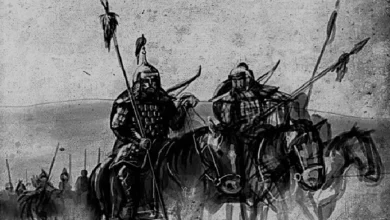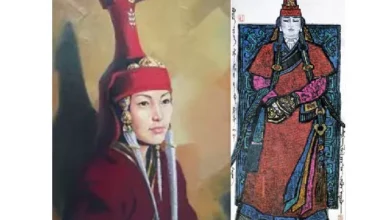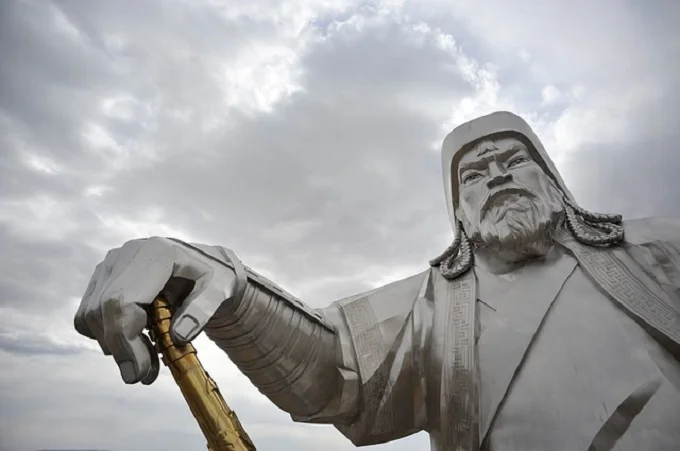Olgoi-Khorkhoi – the terrible guardian of the grave of Genghis Khan

A terrible monster of the Mongolian deserts, a meeting with which does not bode well. Due to the fear of the giant worm, the inhabitants of the area have developed some rules of behavior on the streets, but even this does not always save them from the wrath of Olgoi-Khorkhoi. Several expeditions went in search of the mysterious sandworm, most of them returned with nothing, others did not return at all.
For thousands of years, the Mongols lived in the neighborhood with mysterious creatures. Tales about it, in parallel with the rules of behavior in the desert, adults passed on to their children, one might say with mother’s milk. The first to tell world science and describe the Mongolian death worm was an explorer N. M. Przhevalsky. Traveling through the unexplored areas of the Gobi Desert, he heard many times from the indigenous people stories about the worm Olgoi-Khorkhoi.
Nikolai Mikhailovich tries to find a creature unknown to science, and in subsequent years he will send several groups to search for it. But unfortunately, and perhaps, fortunately, they failed to find the worm.
Worm Olgoy-Khorhoy: what it looks like and what is dangerous
The creature’s name reflects its external appearance: “olgoi” means large intestine, “khorkhoi” means a worm. The description of the monster from ancient legends, and the testimony of modern eyewitnesses, coincide. The Mongolian worm is about 50-70 cm long, sometimes there are references to worms of 1.5 meters, but most researchers consider the last figure to be exaggerated. The thickness is about the size of a human hand. It does not have a head, eyes, or other distinguishing features, the monster looks the same from all sides, and it is impossible to understand where his butt is and where his front is. The color is red-brown, dark orange, there are references to yellow worms.

Olgoi-Khorkhoi is poisonous, it spits his poison at a distance. Others believe that it is not a poison, but something like an acid. In any case, the victim attacked by a mysterious creature dies instantly.
In addition to poison, the mysterious worm has the ability to emit powerful electrical discharges. Local shepherds, peasants, never stick any objects into the ground. Cases have been recorded when sticking a pole, a support of a temporary residential structure, or another object into the sand, a person received a strong electric discharge. At the same time, the current spread for several meters around. No one survived this blow.
According to the indigenous people, if the monster is wounded, the liquid contained in it, upon contact with some surfaces, including metal, reacts and even partially dissolves solid objects. The poison that the worm spits also works in a similar way.
Where does the poisonous worm live?
This dangerous monster lives in the sand dunes of the Gobi, is less common in the semi-desert zones of Mongolia. There are reports that it was seen several times in the past in China, but there is no more or less objective data about Olgoi-Khorkhoi in China.

The giant worm moves under the soil surface at a shallow depth. Most often manifests itself in the hottest months, crawls out to the surface after rain, when the ground is wet. A number of researchers suggest that the worm hibernates for several months of the year, and leads an active lifestyle during the season that is favorable for itself. To get the latest stories, install our app here.
Mongolia is a state with a vast territory, the vast majority of citizens live in the capitals. Most of the lands are poorly studied and uninhabited steppes, semi-deserts, deserts, forests. Thousands of years ago in Mongolia, there were a lot of forests, but gradually the trees disappeared, and desert territories took their place. Small islands of coniferous forests, in the middle of the steppes and sands, today can be seen on the slopes of the hills. They look quite amazing, a forest in the middle of a lifeless wasteland. There is a hypothesis according to which, in one of these forests, there is the grave of Genghis Khan. But to get to this forest, you need to drive hundreds of kilometers through lifeless semi-deserts.
This gave rise to a legend, according to which, Olgoi-Khorkhoi is the guardian of the ruler’s tomb, guards his peace, and punishes uninvited guests.
Mysterious creature in the desert
An interesting incident occurred in the second half of the 20th century. A group of military men was driving along a deserted road in a minibus. On the side of the road, they noticed a previously unseen worm that swarmed over the surface of the earth. The visible part was 40-60 cm, the rest was hidden in the ground. The military poured kerosene around and threw a match. Then there was an explosion. The soldiers were lucky that they were standing a few meters away from the monster. No one expected such a result, because they had not heard of exploding worms before.
In 1954, a group of 6 American explorers set out on two off-road vehicles to explore the sparsely populated areas of Mongolia. According to some reports, travelers were looking for the grave of Genghis Khan. None of the explorers returned.
Looking for the monster
Since the publication of the first information about a huge worm in the 19th century, hundreds of expeditions have visited Mongolia. It is impossible to list them all and publish the results within this article (it will turn out to be a very large volume), so we will try to briefly talk about the main ones:
In the 20s of the last century, numerous expeditions led by the zoologist R. Andrews worked in the Gobi desert for more than 3 years. According to its results, the researcher wrote the book “In the footsteps of an ancient man”, where he spoke in detail about the killer worm.
From 1946 to 1949, a group of geologists and writer I. Efremov worked in the lost corners of Mongolia. He also published the book “Road of the Winds” including information about Olgoi-Khorkhoi.
In the 90s of the XX century, the Czech writer and journalist Ivan Makarle carried out serious work in the deserts of Mongolia. He managed to collect a lot of evidence in favor of the real existence of a giant worm. There was so much data that, based on the results of the expedition, a series of documentaries “The Mysterious Monster of the Mongolian Sands” was launched on television.
Today, enthusiasts and film crews of various TV channels are mainly engaged in the search for a dangerous worm. It should be noted that the government of Mongolia is extremely reluctant to issue permits for activities in the regions where the Olgoi-Khorkhoi is supposed to live. And the point here is not the monster itself, it’s just that the Mongols consider some lands in these places almost sacred, according to their legends, there is also the grave of Genghis Khan, the search for which is opposed by almost the entire population of Mongolia.
Researchers’ opinion
Specialists involved in the study of the phenomenon of a huge worm agree that Olgoi-Khorkhoi is a very real, but not yet studied creature. To get the latest stories, install our app here.
Most believe that this is a giant ringed worm. The features possessed by the monster, according to the researchers, are not surprising. Some modern snakes known to science are spitting venom. As for electrical discharges, the explanation is as follows: the worm accumulates electricity as a result of rubbing its body against the sand while moving. For the creature itself, it is not dangerous, but it poses a mortal threat to anyone who approaches the monster at a distance of 2-3 meters.




